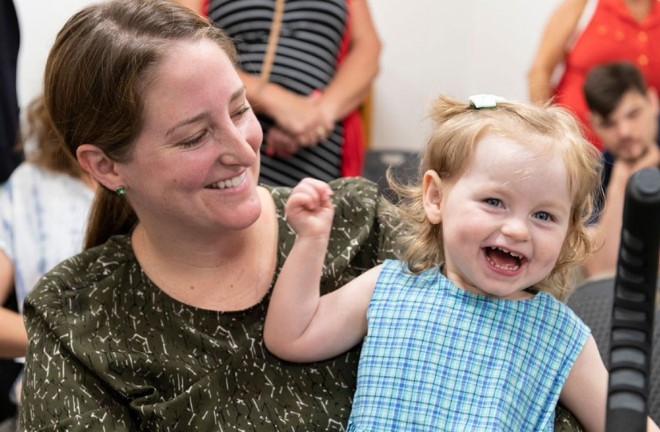Inside the global hunt for a culprit in mysterious hepatitis cases

Within a week, a second child with the same symptoms showed up at Children’s of Alabama. And then a third. “Sometimes in medicine, cases come in threes, so we started to think, ‘Maybe three cases and we’ll be done,’ ” Gutierrez said.
But the cases kept coming. Over the next four months, doctors would care for nine children, all younger than 6, with severe liver inflammation of unknown origin. Two children were transported to an out-of-state hospital for liver transplants.
What Alabama doctors believed was a local outbreak last October has since burgeoned into a mysterious global eruption involving at least 450 children across 20 countries, including 109 in the United States. Eleven children have died, including five in the United States. More than two dozen have needed liver transplants — 15 in this country.
“It’s extremely unusual because these are healthy children,” most of them younger than 5, said Elizabeth Whittaker, a pediatric infectious diseases specialist at Imperial College in London, who is assisting the investigation in the United Kingdom, which has reported 176 cases, the largest number of any country. Mild hepatitis is fairly common in children, she said, but doctors are seeing something quite different and alarming: children with liver injury severe enough to require transplants. Typically, the U.K. might have eight to 10 such transplants in a year, she said. This year, it has had 11 in three months.
The growing constellation of cases has spurred an international hunt to identify the culprit, with disease detectives and researchers from global health agencies, the United States, the U.K., Israel, Italy and Japan weighing in to share data and hypotheses. Hepatitis, which is an inflammation of the liver, is typically caused by one of several known viruses — hepatitis A, B, C, D or E. But those have all been ruled out in these cases, which are also unusually severe.
After seven months, “we have not had any ‘aha’ moments,” Whittaker acknowledged. But the accumulating evidence points to two leading suspects — a pair of viruses, working singly or perhaps in tandem. One is adenovirus — a common family of viruses that cause symptoms ranging from the common cold to pinkeye. The second is the coronavirus responsible for the pandemic, which some doctors theorize may have contributed to liver inflammation through an old infection or a co-infection that has triggered the immune system to overreact.
Alongside the doctors working frantically to solve the mystery are scores of families who watched as their children went from what seemed like everyday bouts of stomach upset, diarrhea and vomiting to severe liver inflammation to liver failure — and, in a handful of cases, were told their children needed transplants. Some are now sharing the details of their experiences to help solve the mystery.
The search has been challenging, full of tantalizing but inconclusive leads, in part because doctors in different countries have tested for different things and there are not yet standardized protocols. The strongest evidence tying the hepatitis cases to adenovirus are test results that showed it in the blood of more than half the children in the United States and nearly three-fourths of those in the U.K. Some of the children also tested positive for the same adenovirus 41 strain associated with severe stomach illness.
But doctors are baffled that they have yet to find adenovirus in the liver tissue, which they would expect to find there if it was causing the injury.
“Not finding it in the liver, to date, is something that obviously is a bit perplexing,” said Umesh Parashar, chief of the Centers for Disease Control and Prevention’s viral gastroenteritis branch, who leads a team of 35 to 40 officials investigating the cases in the United States.
“We are stumped,” said Markus Buchfellner, a pediatric infectious diseases physician at the University of Alabama at Birmingham, who has been part of the team probing the Alabama cases since October.
Last week, the CDC sent an updated advisory to clinicians with more-specific recommendations on adenovirus testing.
Doctors in Israel have theorized that the hepatitis is linked to the pandemic because most of their several dozen sick children showed evidence of past coronavirus infections. Israel has seen more than 40 cases of the severe hepatitis in children, including two infants who received transplants.
“Some of us think that the only thing that changed in the last year is COVID-19,” Eyal Shteyer, who heads the pediatric liver unit at Shaare Zedek Medical Center in Jerusalem, where seven children were treated, wrote in an email. “I think that covid caused some immune dysregulation that led to the hepatitis.”
U.S. and U.K. doctors have noted that few of the children they treated for hepatitis had documented coronavirus infections. Studies, however, have shown that three-quarters of children in this country and more than 95 percent of those in the U.K. have covid-19 antibodies indicating past infections.
Investigators are exploring other theories as well, including whether young children who had fewer social interactions during the pandemic may have been more susceptible to adenovirus. They’re also looking at whether a more lethal adenovirus might have emerged, and whether a co-infection with the coronavirus could make adenovirus “manifest in a way that has not been commonly seen before,” said Jay Butler, the CDC’s deputy director of infectious disease.
A letter published Friday in the Lancet suggests that part of the coronavirus’s spike protein resembles a bacterial toxin and may be causing the immune system to go haywire when there is a co-infection with adenovirus 41.
Other possibilities under exploration include a potential link to dogs after U.K. investigators also noticed that 70 percent of their children came from dog-owning families, or had other dog exposures. The significance of that finding “is being explored,” investigators said.
‘Something big is going on’
In a Cincinnati suburb, Elizabeth Widders wasn’t too worried when her 4-year-old daughter, Liviah, started throwing up a few weeks before Christmas. Elizabeth figured the little girl had eaten too much candy at a sleepover at her grandmother’s house the night before. Liviah was her usual cheerful self, with no fever or other sign of illness. When her older brother started vomiting and spiked a fever, the Widderses assumed both kids had a stomach bug.
But a few days before Christmas, Elizabeth was struck as she did her daughter’s hair that the whites of the girl’s eyes had turned yellow. Liviah also confided that “her pee was orange.” The mother of three guessed right away that it was jaundice.
Jack Widders couldn’t see the yellowing until they moved from the kitchen into the foyer, with more natural light. It was obvious to him then, too. “One thing we’ve been telling parents … get your kids in natural light, check out their eyes,” Elizabeth has since counseled others.
After they rushed Liviah to a hospital emergency room, Elizabeth also noticed that part of the child’s stool was light-colored, another telltale sign of liver problems.
Within hours, Liviah was transferred to Cincinnati Children’s Hospital Medical Center. Tests there showed that she had an enlarged liver and extraordinarily high liver enzymes, signs of inflammation. “That, for us, was like the first punch in the gut,” Elizabeth said.
Over the next week and a half, the Widderses rode an emotional roller coaster, elated by seeming improvements, only to despair over indicators of the severe damage to their daughter’s liver. “Her skin was essentially yellow,” Jack recalled.
Still, the couple were stunned when doctors told them only a few days later that their little girl needed a liver transplant. While she waited for a donor, she received special therapy to wash her blood of toxins, a function normally performed by her liver.
The next few days unfolded in a blur of anxiety. On New Year’s Day, Liviah received an organ from a deceased child donor. “In 11 days, she went from a perfectly healthy girl to a transplant recipient,” Jack said.
The Widderses said doctors had no idea what was making Liviah sick. Adenovirus was found in her blood but not in her diseased liver, which doctors would have expected if the virus had caused direct injury, said Jorge Bezerra, director of the hospital’s Pediatric Liver Care Center. He noted that it is possible the immune system had cleared the virus from the organ, making it difficult to find.
She also had no sign of coronavirus antibodies before the operation, but tested positive afterward, which doctors attributed to blood transfusions.
“It is a mystery,” Bezerra said.
Liviah’s case is among six under investigation at the Cincinnati hospital since the CDC issued a national alert April 21 warning doctors to watch for cases of unexplained severe hepatitis in children, Bezerra said.
Only two of those children — Liviah and one other — tested positive for adenovirus. Some adenovirus strains are spread through close contact, but there was no history of that between the two cases, he said.
‘Why aren’t we seeing these cases anywhere else in the country?’
When outbreaks occur, disease detectives are trained to seek the cause by looking for connections among the people who get sick, the places they fall ill or have recently traveled to, and the timing of those illnesses.
In Alabama, Gutierrez, Buchfellner and Henry Shiau, another pediatric gastroenterologist at the children’s hospital, began searching for a pattern among their cases in late October, pinning markers on a map representing the children’s Zip codes. But the patients came from all over Alabama, three to four hours’ drive from one another, making it unlikely the families could have met or communicated, Buchfellner said. That ruled out a transmission pathway, because adenovirus 41, which was found in the first five children, is spread through close contact.
If geography played no role, the doctors wondered why they hadn’t heard of other reports. They checked with pediatric colleagues elsewhere, but no one had similar cases.
“There was always that thought in the back of my head: ‘Why aren’t we seeing these cases anywhere else in the country?’ ” Buchfellner recalled.
In November, after their fourth case, doctors sought help from the CDC. They wanted to know if it was unusual to have so many cases of acute hepatitis and noted that “all had tested positive for adenovirus,” said Jackie Tate, an epidemiologist with the CDC’s viral gastroenteritis office.
Federal health officials confirmed that it was definitely unusual. Adenovirus had previously been associated with severe liver disease only in immunocompromised children. But they had no idea if the Alabama cluster might be part of something bigger.
In February, the Alabama Health Department alerted clinicians throughout the state to be on the lookout for additional cases. None were reported.
Everything would change in late March, when doctors thousands of miles away in Scotland reported a group of 14 children with unusual and severe hepatitis, also of unknown cause. That prompted the U.K. Health Security Agency to send out an alert in early April. Two weeks later, the CDC followed with its own nationwide alert about the Alabama children. It asked clinicians to test unexplained hepatitis cases for adenovirus and to report them to state and federal health officials.
Almost immediately, reports began trickling in. North Carolina reported two cases; Illinois, three. Wisconsin was investigating four cases, including a child who needed a transplant, and the first U.S. death. The 109 cases currently being investigated by the CDC come from 25 states and Puerto Rico.
Asked why the CDC didn’t alert doctors sooner, Parashar said the agency was aware only of the Alabama cases “and so we were a bit perplexed — is this bigger or not?” But after the illness started popping up in other countries, “that raised the vigilance for all of us,” he said.
And as cases continued climbing in the past month, investigators mobilized an elite cadre of experts. Besides the pediatricians and liver disease specialists already involved, they brought in immunologists to see whether the children’s immune systems might be misfiring, toxicologists to analyze urine and blood specimens for toxins, and pathologists to look for clues in liver biopsies, among others.
Some of the biggest contributions to the investigation have come from the U.K. because hospitals in England regularly test for adenovirus. It also randomly samples the population to see what viruses are circulating.
That surveillance turned up a surprising finding: “There was a massive peak of adenovirus this winter in the under-5 age group that has not been seen in any of the last five years,” said Whittaker, of Imperial College, noting that young children often have different responses to new viruses than older children or adults do. “We have to assume that one way or the other, it may be playing a role, whether in combination with covid or independent of covid.”
But establishing proof of those links may be difficult because many of the hepatitis cases occurred months ago, when few clinicians collected the kind of tissue specimens investigators say they need to solve the mystery.
In November, the CDC reached out to New York state’s Wadsworth Center, one of the nation’s premier public health labs for genetic sequencing and one of the few that can test for adenovirus. They sought to learn if an unusual combination of genes or mutations in the adenovirus strains found in the blood of the sick children might explain “why it is suddenly causing a disease phenomenon,” said Kirsten St. George, Wadsworth’s chief of viral diseases.
Wadsworth identified adenovirus 41 in five of the nine Alabama children, the same strain found in 18 out of 18 U.K. children who had sufficient viral loads in their specimens to allow for the testing. The problem is that most of the children did not have enough concentration of the virus to enable more-sophisticated testing for a specific strain or to find out whether that strain might be novel.
“You can sequence parts of the virus,” said the CDC’s Parashar. “But it’s like the elephant story. If you catch the ear, you call it a different animal than if you catch the tail. You need to look at the full sequence to really be able to see if it’s something unusual … compared with the typical adenovirus strain.”
The role of the coronavirus
The possible role of the coronavirus in the outbreaks is even more confounding because of the difficulty of establishing whether the children may have had undiagnosed earlier infections that affected their immune systems.
None of the nine Alabama children had received a coronavirus vaccine before their hospitalizations because they were too young to be eligible. And none had a documented covid-19 illness during their hospitalizations or before. But the children were not tested for coronavirus antibodies to look for evidence of prior infections.
U.K. investigators detected the coronavirus in 24 of 132 cases, and investigators found some instances of adenovirus and coronavirus co-infection. They are “rigorously testing” the association with adenovirus, as well as “the role of other contributors, including prior SARS-CoV-2 and other infections,” Meera Chand, a top U.K. health official, said in a May 12 statement. (SARS-CoV-2 is the formal name for the coronavirus.)
U.K. and U.S. investigators said the widespread prevalence of coronavirus infection in children makes it hard to assess its role. It’s possible that a previous coronavirus infection could be “modifying what adenovirus does in the children,” the CDC’s Parashar said.
Doctors in Israel are big exponents of the idea that the hepatitis cases are related to previous coronavirus infections.
Shteyer, the Jerusalem specialist, acknowledged that the different perspectives may reflect different testing approaches among countries — and perhaps even different diseases. Israeli doctors have not done extensive testing for adenovirus, he said, but plan to do so now.
He urged the adoption of common testing protocols worldwide to investigate the cases.
Liviah Widders was lucky to have been diagnosed quickly, and even luckier to get a new liver in four days.
But she’s also had big adjustments. Because of her weakened immune system — she received high doses of steroids to prevent her body from rejecting the donor liver — her preschool teacher taught her remotely until just recently, when she recovered enough to go back to school, resume dance classes and play in her first soccer game.
Her parents have explained to her that someone gave her a new liver, but that’s been hard for the youngster to comprehend fully. But Liviah, who loves dressing up as a princess, is proud of the backward-L-shaped incision on her right side, just above her belly button.
“We call it her princess mark, and she is happy to share it and show it to anyone,” Jack Widders said.
The anti-rejection medication is hard on Liviah’s kidneys, and her parents want her to drink 56 ounces of liquids daily. A water bottle chart on the kitchen refrigerator is a reminder.
“We’re instilling these things to take care of herself, because this is going to be a forever thing for her,” Elizabeth Widders said.







